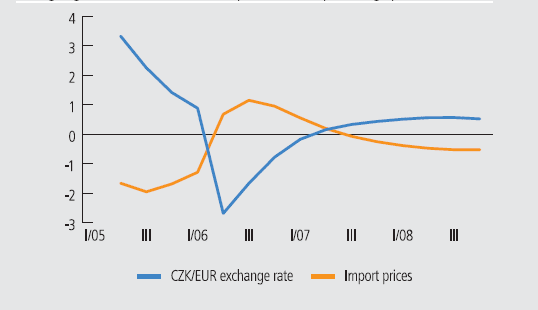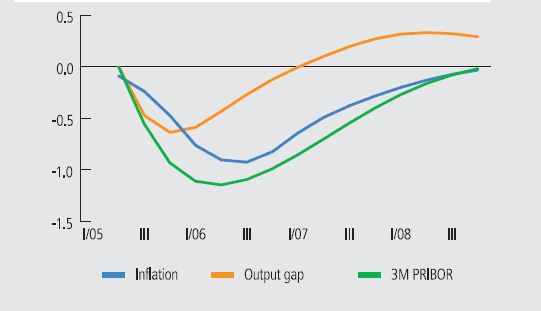The effect of the exchange rate on inflation
The exchange rate is one of the macroeconomic fundamentals which significantly affect consumer price inflation. In a small and relatively open economy such as the Czech Republic, two channels through which the exchange rate affects inflation can in principle be monitored.
Chart 1
Exchange rate shock - initial appreciation (of 1 CZK/EUR); affect on import prices
(change against baseline scenario of April forecast in percentage points)

The first is the 'direct channel", whereby the exchange rate affects, with a relatively small lag, prices of imported goods, i.e. goods intended directly for the consumer market as well as raw materials and semi-manufactures intended for production of consumer goods of domestic origin. The exchange rate affects not only prices of imported goods, but also - indirectly via import arbitrage - prices of domestic goods which are under competitive pressure from imported goods.
The second channel is the 'indirect channel", whereby the change in the exchange rate, all other things being equal, affects the change in the real exchange rate. This, in turn, affects the economy via aggregate demand and a changed output gap (see the box in the October 2003 Inflation Report). However, by comparison with the direct exchange rate channel, the pass-through of the exchange rate change into the real exchange rate via impacts on economic activity and subsequently on inflation, is relatively slow.
Under its monetary policy regime of inflation targeting and a freely floating exchange rate, the CNB does not directly regulate the exchange rate. However, since changes in the exchange rate also affect inflation, the CNB conducts detailed analyses of the exchange rate, and each CNB macroeconomic forecast also contains the internally consistent outlook for the exchange rate. On the one hand, the exchange rate forecast affects future inflation and thus also monetary policy, which is aimed at keeping inflation near the inflation target. On the other hand, the exchange rate is in turn affected by monetary policy (via the difference between domestic and foreign interest rates).
The CNB's forecasting system enables it to analyse the impacts of deviations of the exchange rate from the baseline outlook contained in the forecast. This can be illustrated using the example of an appreciation of 1 koruna against the euro (i.e. a change of approximately 3% at the current exchange rate) against the starting assumptions of the baseline scenario in the first quarter of the forecast, with the euro-dollar exchange rate remaining unchanged (i.e. with simultaneous appreciation of the koruna-dollar rate). This simulation, which, however, does not constitute a full forecast, is illustrated in Charts 1 and 2. Inflation would start deviating downwards from the baseline scenario, and monetary policy, all other things being equal, would have to respond to this situation with lower interest rates than in the baseline scenario.
Chart 2
Exchange rate shock - affect on output gap, nominal interest rates and inflation
(change against baseline scenario of April forecast in percentage points)

Overall, the inflation outlook in this illustrative example would decrease by around 0.8% at the one-year horizon compared to the baseline scenario. The model monetary policy response to the change towards a lower annual inflation path would be to lower interest rates by around 1%. At the same time, the lower nominal interest rates would cause the exchange rate to depreciate and would ease the monetary conditions tightened by the original exchange rate shock. At the horizon of approximately 18 months, the exchange rate would gradually return to the outlook contained in the baseline scenario of the forecast. Interest rates and inflation would follow it with a lag, at the horizon of two to three years.